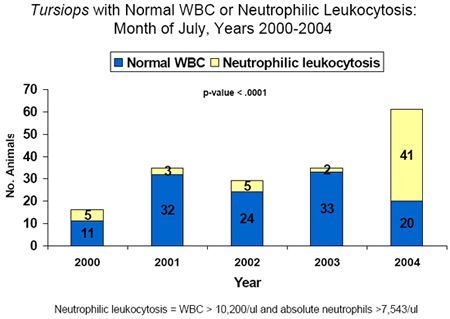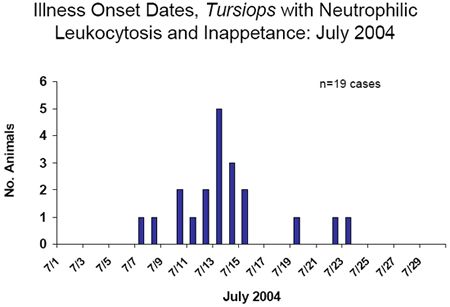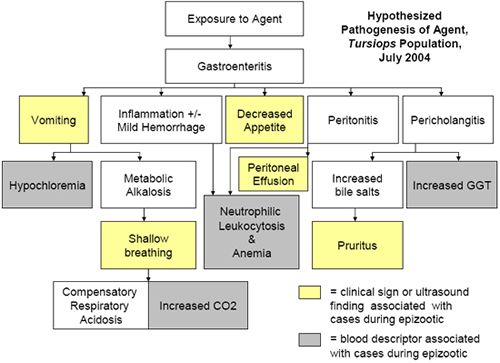Abstract
An epizootic is an unexpected increase of illness within a specific population over a defined period of time. During July 2004, there was an epizootic associated with decreased appetites and neutrophilic leukocytosis in Atlantic and Pacific bottlenose dolphins (Tursiops truncatus) at the Navy Marine Mammal Program (NMMP). This abstract summarizes outcomes from the epidemiologic investigation.
Baseline data on clinical signs and white blood cell counts were used to characterize the event as unexpected and clinically relevant (Graph 1). Cases were defined as NMMP Tursiops with a neutrophilic leukocytosis (white blood cell count > 10,200/uL and absolute neutrophil count > 7,543/uL) between 01 and 30 July 2004. Of 67 dolphins in the San Diego population, 42 (63%) were identified as cases. Of these animals, 19 (45%) had decreased appetites; the remaining cases had high WBC counts but maintained normal appetites. Seventy-five percent of cases resolved within 26 days (range 3-96 days) of illness onset.
A summary of clinical case onset dates is provided (Graph 2); the shape of the histogram is consistent with introduction of an agent from a single source. The epizootic did not appear to affect sea lions or humans working in the same environment as affected dolphins. There were no significant differences between cases and non-cases when comparing age, sex, Tursiops truncatus truncatus versus Tursiops truncatus gilli, pier location, or diet (data not shown).
differences between cases and non-cases when comparing age, sex, Tursiops truncatus truncatus versus Tursiops truncatus gilli, pier location, or diet (data not shown).
Clinical signs reported by veterinarians included inappetance (45%), vomiting or regurgitation (29%), pruritus (26%), blepharospasms (24%), shallow breathing (17%), pleural, pericardial and/or peritoneal effusions (17%), and tongue lesions (7%). In addition to a neutrophilic leukocytosis, cases were significantly (p-value < .01) more likely to have a monocytosis (93% of cases), high erythrocyte sedimentation rate (76%), hypochloremia (51%), hypercapnia (51%), normocytic, normochromic anemia with increased reticulocytes (34%), and a high GGT (20%) compared to the baseline population (blood values from Tursiops during the month of July, years 2000-2003).* The combination of clinical signs and blood data support introduction of an agent that affects the gastrointestinal system (Figure 1).
Antimicrobials were used judiciously to minimize the development of antimicrobial resistance. Of 42 cases, 24 (57%) animals received antimicrobials and 18 (43%) received no antimicrobials.
There were no significant (p-value < .01) differences in mean white blood cell count (9,900/uL v. 9,350/uL), monocyte count (320/uL v. 300/uL), serum carbon dioxide levels (both 24 mEq/L), or duration of neutrophilic leukocytosis (20 days v 21 days) when comparing antimicrobial-treated cases with non-antimicrobial treated cases. Thus, compared to supportive care alone, antimicrobials did not appear to significantly decrease the duration of illness or demonstrate protective effects for the primary disease in this epizootic. Use of antimicrobials, however, may have prevented or treated secondary or advanced primary infections.
To summarize, the etiology of the epizootic appeared to be a species-specific agent introduced by a single source that primarily caused mild gastrointestinal disease (but may have also affected ophthalmic, mucosal, and respiratory systems) and resolved with supportive care within 1 month. Dolphins, regardless of age, gender, or location within San Diego Bay, appeared equally susceptible to the agent. There was no evidence of a harmful algal bloom in San Diego during July 2004, and all tests for the usual suspects (Brucella sp., calicivirus, Erysipelothrix rhusiopathiae, hepatitis, morbillivirus, influenza virus, herpesvirus, and West Nile virus) were negative on multiple tissues from multiple animals.
The etiology of an epizootic is often unknown when the event is occurring. While there is an ongoing need to identify specific marine mammal pathogens, in-the-trench epidemiology may help veterinarians confirm the presence of an epizootic; determine the duration of disease; define, detect, track, and control cases; describe agent pathogenesis; and determine effective treatments when the etiology is unknown.
 Significance defined as p-value < .0001
Significance defined as p-value < .0001
*Monocytosis= > 462 /uL; high ESR = >19 mm/hr; hypochloremia = <115.6 mmol/L; hypercapnia = >26.4mEq/L; anemia=HCT<38%; high GGT = >92 u/L
Acknowledgments
The authors would like to thank Dr. Jeremiah Saliki, the team at the Oklahoma Animal Disease Diagnostic Laboratory, Dr. Kerrie Vaughan, and Dr. Kara Sorensen for their time and expertise during the epizootic investigation. Additionally, the authors thank the NMMP management for their efforts to protect both human and animal health. Finally, we thank the animal handlers and trainers at the NMMP for their vigilance and dedication to the health of every animal.
| Graph 1. | 
Number of Tursiops with neutrophilic leukocytosis, month of July, years 2000-2004. July 2004 had a significantly higher number of animals with neutrophilic leukocytosis compared to July, years 2000-2003. |
|
| |
| Graph 2. | 
Histogram of illness onset dates for MMP Tursiops, July 2004. Of 42 identified cases (Tursiops with neutrophilic leukocytosis), 19 (45.2%) had decreased appetites. |
|
| |
| Figure 1. | 
Hypothesized pathogenesis of agent, Tursiops population, July 2004. |
|
| |